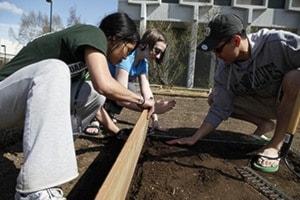There might be some clouds, and a sprinkle or two, this weekend, but looking at the weather the past week and the upcoming one, gardening season is upon us.
Trees are blooming and horticultural growth is everywhere — the lawn’s already been mowed twice already.
When it comes to garden beds, now is the time to get out, and clear the waste material to prepare for planting anew.
But awakening the garden to a new growing season is about more than soil and seedlings.
This rite of spring is a tonic to the gardener, as well.
Some tips to get the garden and home going for spring.
• Clear drainage ditches: Leaves and other debris can often gather in drainage areas over the winter.
Now is the time to ensure that these spring showers have adequate runoff.
And, as spring seedlings do best in soil that drains well, and because vegetative growth is at a low point in early spring, this is the easiest time of year for clearing drainage ditches.
Be sure to put the cleared material – usually dead leaves, and small branches and other natural waste material – into the compost. Spring compost piles are commonly short on carbon-rich materials, and every addition helps.
• Repair garden structures: This is the best time of the year to fix any bowed sides to raised beds, or repair trellises and fencing.
Wet winter soil can strain the wood on raised garden beds, so any bowed or leaning sides should be fixed now.
Dig back the soil behind the bowed side and drive new stakes in, on the inside of the sideboards, with a slight lean inward.
Push the sideboards up to the stakes and screw the sideboard into the stakes.
Trellises and fencing are also best repaired in the early spring as there’s less growth and roots to work around.
However, setting new fence posts is better done after spring’s rains have drained through the ground.
A high water table will fill post holes with water as you dig.
• Weed and mulch: Garden bed weeds, with their shallow roots, are easiest and best pulled now.
So is covering your garden’s bare spots with mulch to minimize the growth of new weeds.
An appropriate amount of mulch to add would be to a depth of about three or four inches.
Black sheeting can also be used to cover garden beds, before planting, as a way to help prevent weeds.
Make sure that when you’re adding mulch, you keep it a few inches away from tree trunks and the stems of plants to help reduce rot on the stems of young plants and to protect the bark of young fruit trees.
• Plant early spring vegetables: Garden soil is ready to go once it is free of ice crystals and it crumbles easily. Soil that is too wet is easily compacted, which reduces soil aeration.
Common early spring crops are peas, spinach, lettuces and leeks.
Follow these crops with broccoli, cabbage, radishes, kale, turnips, new potatoes and onions.
• When it’s dry enough, top-dress beds: Top-dress garden beds with compost or well-seasoned manure in preparation for planting.
Resist the urge to dig the bed; established beds have a complex soil ecosystem which is best left undisturbed. Nutrients added from the top will work their way down into the soil.
Get out and enjoy the Lower Mainland’s early spring sunshine in your gardens.
– By Kevin Gillies, a freelance writer for Black Press.
